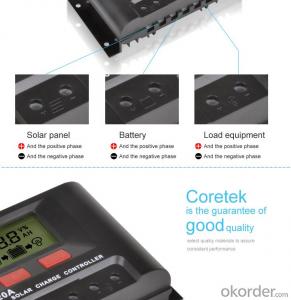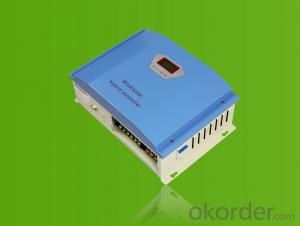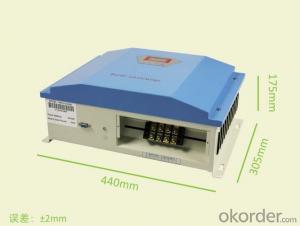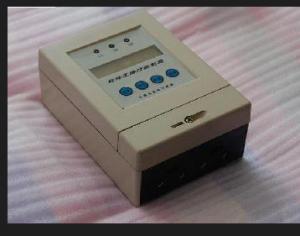MPPT Solar Charge Controllers Pso Solar LCD Controller CY20B
- Loading Port:
- China main port
- Payment Terms:
- TT or LC
- Min Order Qty:
- 1 unit
- Supply Capability:
- 10000 unit/month
OKorder Service Pledge
OKorder Financial Service
You Might Also Like
Product Introduction
Solar controller is control device which can control solar panel and transform solar energy into electricity then store to the battery bank. Solar controller is the most important part in offgrid system, whose performance has much effect on life expectancy and operation of the whole system, especially the battery expectancy.
Application Areas
Standalone Photovoltaic power station
Standalone Domestic household photovoltaic power system
Mobil communication base stations, expressway and other non-residential regions.
Coastal islands, remote mountainous, border posts for regions shortage of or without electricity.
Government demonstration projects, landscape lighting project etc.

Selection of high-quality materials properties be consistent from beginning to end
For life is a convenient
A little more secure
The innovation design idea of the perfect show
The first set of people-oriented
The high-end configuration components
- Q: What are the advantages of using an MPPT solar controller?
- The advantages of using an MPPT (Maximum Power Point Tracking) solar controller include increased efficiency and power output from solar panels, the ability to charge batteries more quickly and effectively, and improved performance in low-light or fluctuating weather conditions. MPPT controllers can also provide real-time monitoring and data logging capabilities, allowing for better system management and maintenance. Additionally, MPPT controllers are generally more versatile and compatible with various types of solar panels and battery systems.
- Q: Can a solar controller be used with a solar-powered camera system?
- Yes, a solar controller can be used with a solar-powered camera system. A solar controller helps regulate the flow of electricity from the solar panels to the camera system, ensuring optimal charging and preventing overcharging or damage to the batteries. It also helps manage power consumption and maximize the efficiency of the solar-powered camera system.
- Q: What is the role of a display screen in a solar controller?
- The role of a display screen in a solar controller is to provide real-time information and control options to the user. It allows them to monitor and adjust settings such as battery voltage, charging status, load usage, and other parameters related to the solar power system. The display screen also helps in troubleshooting and diagnosing any issues that may arise, ensuring efficient and effective utilization of solar energy.
- Q: Can a solar controller be used for both solar panels and batteries?
- Yes, a solar controller can be used for both solar panels and batteries. It regulates the flow of electricity from the solar panels to the batteries, ensuring that the batteries are charged efficiently and preventing overcharging.
- Q: Can a solar controller be used with a generator?
- Yes, a solar controller can be used with a generator. The solar controller regulates the charging of batteries from solar panels, and it can also regulate the charging from a generator. By connecting the generator's output to the input terminals of the solar controller, it can effectively manage the charging process and ensure the batteries are charged efficiently.
- Q: What is the maximum power rating of a solar controller?
- The maximum power rating of a solar controller typically depends on the specific model and brand. However, in general, solar controllers are available in a range of power ratings, with some capable of handling lower wattage systems (e.g., 10-20 watts) and others designed for higher wattage systems (e.g., 100-200 watts or more).
- Q: Can a solar controller be used in a solar-powered electric skateboard charging system?
- Yes, a solar controller can be used in a solar-powered electric skateboard charging system. A solar controller helps regulate the voltage and current from a solar panel to ensure efficient charging and protect the batteries. By connecting a solar controller to the solar panel and the electric skateboard's battery, it can effectively manage the charging process and optimize the use of solar energy.
- Q: How do I integrate a solar controller with an existing solar panel system?
- To integrate a solar controller with an existing solar panel system, you will need to follow these steps: 1. Determine the compatibility: Ensure that the solar controller you want to integrate is compatible with your existing solar panel system. Check the voltage and current ratings of both the solar panels and the controller to ensure they match. 2. Disconnect the existing connections: Turn off the power supply to the solar panel system and disconnect all the existing connections between the solar panels and the charge controller (if any). 3. Mount the solar controller: Find a suitable location to mount the solar controller. It should be near the battery bank and easily accessible for monitoring and maintenance. 4. Connect the solar panels: Connect the positive and negative terminals of the solar panels to the corresponding input terminals on the solar controller. Ensure proper polarity. 5. Connect the battery bank: Connect the positive and negative terminals of the battery bank to the corresponding output terminals on the solar controller. Again, ensure proper polarity. 6. Check the settings: Set the appropriate charging parameters on the solar controller according to the battery type and capacity. This may include voltage thresholds, charging modes, and temperature compensation. 7. Reconnect the power supply: Once everything is properly connected and configured, reconnect the power supply to the solar panel system. The solar controller will now regulate the charging of the battery bank, optimizing the performance and lifespan of your solar panel system.
- Q: Can a solar controller be used in a solar-powered water pump system?
- Yes, a solar controller can be used in a solar-powered water pump system. A solar controller regulates the amount of power generated by the solar panels and ensures that the batteries are charged optimally. Therefore, it is essential in maintaining the efficiency and longevity of the water pump system.
- Q: Can a solar controller handle power surges from the grid?
- No, a solar controller is not designed to handle power surges from the grid. Its primary function is to regulate and control the flow of power from the solar panels to the battery or load, and it does not have the capability to protect against or manage power surges coming from the grid. For that purpose, additional surge protection devices or equipment would be required.
Send your message to us
MPPT Solar Charge Controllers Pso Solar LCD Controller CY20B
- Loading Port:
- China main port
- Payment Terms:
- TT or LC
- Min Order Qty:
- 1 unit
- Supply Capability:
- 10000 unit/month
OKorder Service Pledge
OKorder Financial Service
Similar products
Hot products
Hot Searches
Related keywords

































